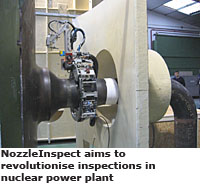New nuclear nozzle inspection robot passes the test
07/02/2012
 A new robotic arm scanner for the automated inspection of nozzle welds in nuclear reactors has successfully completed demonstration trials after two years in development.
A new robotic arm scanner for the automated inspection of nozzle welds in nuclear reactors has successfully completed demonstration trials after two years in development.The trials mark the culmination of a €1.4m EU-funded research and development project, NozzleInspect, which has brought together Phoenix Inspection Systems, Peak NDT and The Welding Institute (TWI) in the UK, alongside partners in five other European countries.
NozzleInspect aims to provide nuclear power plant operators with a versatile inspection machine to revolutionise pre-service and in-service inspections.
Nozzle sections in nuclear reactor pressure vessels are classed as critical components, requiring regular inspections to verify their integrity. The early detection of cracks is essential, however inspection costs are high. A plant shutdown costs operators an estimated €800,000 per day and a typical outage takes around 20 days to complete.
Another problem is that reactor pressure vessel nozzles can be in high radiation areas where test engineers could receive their yearly permissible dose in the time taken to set up some existing scanning systems.
The focus of NozzleInspect has been to reduce the scanner installation time, reduce the overall inspection time, and to investigate ways to apply the latest inspection technologies to improve defect detectability and the accuracy of sizing measurements.
The demonstration system includes a novel flexible phased array probe holder that conforms to the changing curvature of the vessel surface, maintaining consistent coupling throughout. The probe is mounted onto a robotic arm that steers it around the contours, while the control system automatically adapts the arm position to ensure that a constant force is applied to the holder.
The 2D phased array transducer inspects a wide volume from a single position, which reduces the need for manipulation. The use of one probe in turn reduces the size and cost of the robot.
The robot may be clamped on the nozzle pipe within ±100 mm of the nominal correct position. Sensors on the robot automatically register its vertical datum position and measure the distance to the vessel surface as part of a remote set-up procedure to ensure much faster set-up times.
Phoenix developed the flexible probe holder in addition to being the lead SME on the project, guiding the technical specifications for the manipulator. Others involved in the project included Vermon (France), Optel (Poland), CeReTeTh (Greece) and Iberdrola (Spain), which carried out the trials.
Neil Hankinson of Phoenix Inspection Systems said: “Nozzle inspections pose a number of challenges which make them time consuming and expensive. Given the number of ageing nuclear power stations currently in use, life-extension programmes and the demand to build new plants, there is a need for faster, operator-friendly and more accurate inspection systems.
“Our approach, which combines a new phased array transducer design, a novel probe holder, an advanced navigation system with adaptive control and low-cost robot, offers potential for significant improvements, including helping to minimise the inspector’s exposure to hazardous environments. Refinement of the data analysis techniques and standardisation of the software would offer further major benefits, allowing more accurate detection and measurement of defects.”
www.phoenixisl.co.uk